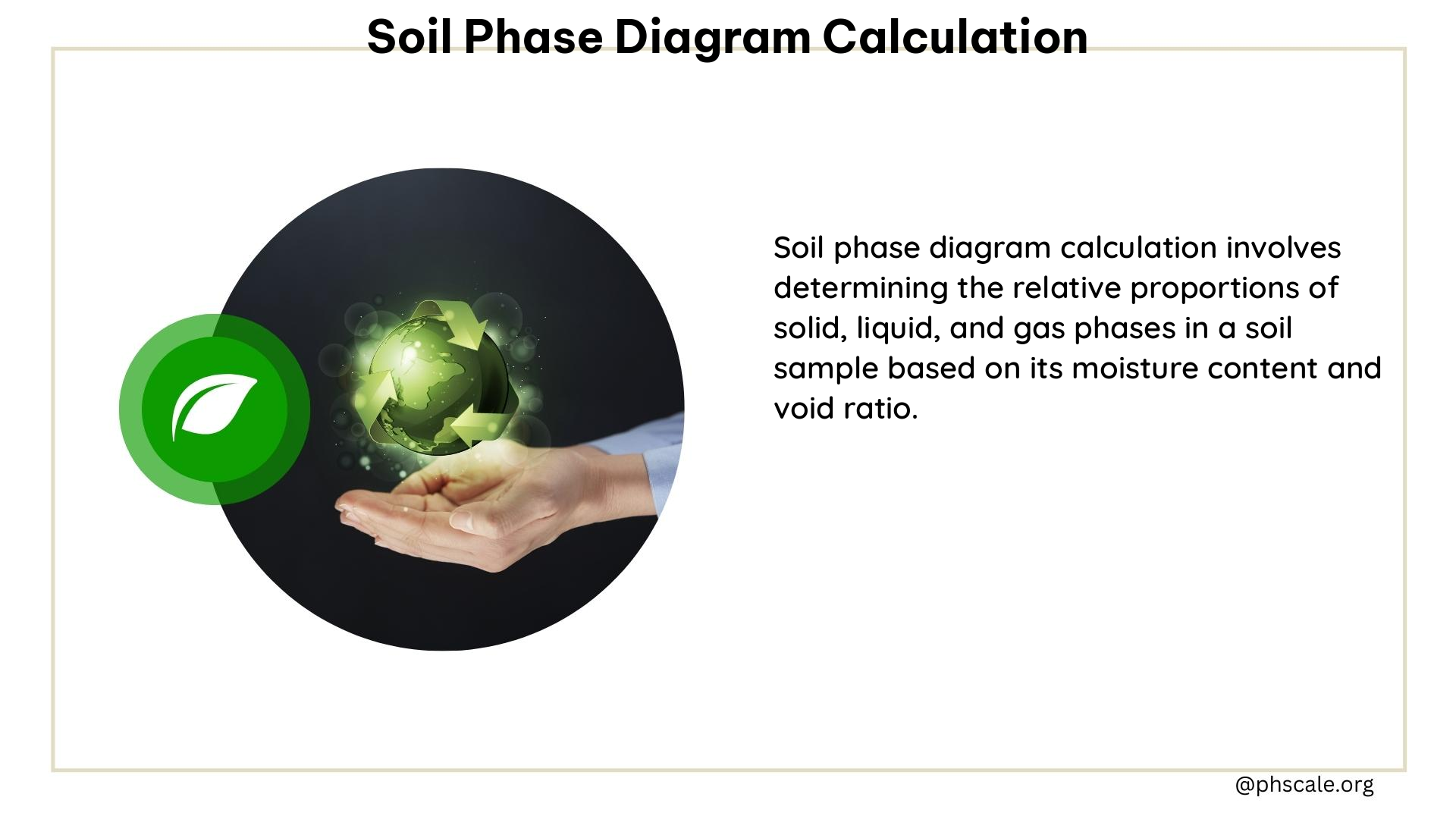Calculating various properties of a soil sample using a soil phase diagram is a crucial step in understanding the composition and behavior of soil. This comprehensive guide will walk you through the step-by-step process of determining moisture content, degree of saturation, void ratio, and porosity of a soil sample. Additionally, we’ll explore common soil contaminants and the methods used to address them.
Calculating Moisture Content
- Determine the mass of the soil sample:
- Weigh the soil sample in its natural condition (e.g., 2290g).
-
Dry the sample in an oven at 105-110°C for 24 hours and reweigh it (e.g., 2035g).
-
Calculate the mass of water:
-
Subtract the dry mass from the natural mass:
Mass of water = 2290g - 2035g = 255g. -
Calculate the moisture content:
- Divide the mass of water by the dry mass and multiply by 100:
Moisture content = (255g / 2035g) * 100 = 12.5%.
Calculating Degree of Saturation

- Determine the volume of water:
-
Divide the mass of water by the density of water (e.g., 106 g/m³):
Volume of water = 255g / 106 g/m³ = 2.4 x 10⁻⁴ m³. -
Determine the volume of voids:
- Calculate the total volume of the sample (e.g., 1.15 x 10⁻³ m³).
- Calculate the volume of solids by dividing the dry mass by the particle density (e.g., 2540 kg/m³):
Volume of solids = 2035g / 2540 kg/m³ = 8.01 x 10⁻⁴ m³. -
Subtract the volume of solids from the total volume:
Volume of voids = 1.15 x 10⁻³ m³ - 8.01 x 10⁻⁴ m³ = 3.49 x 10⁻⁴ m³. -
Calculate the degree of saturation:
- Divide the volume of water by the volume of voids:
Degree of saturation = 2.4 x 10⁻⁴ m³ / 3.49 x 10⁻⁴ m³ = 0.69 or 69%.
Calculating Void Ratio
- Use the calculated volumes of voids and solids:
- Divide the volume of voids by the volume of solids:
Void ratio = 3.49 x 10⁻⁴ m³ / 8.01 x 10⁻⁴ m³ = 0.44 or 44%.
Calculating Porosity
- Use the calculated volumes of voids and the total volume:
- Divide the volume of voids by the total volume:
Porosity = 3.49 x 10⁻⁴ m³ / 1.15 x 10⁻³ m³ = 0.303 or 30.3%.
Soil Phase Diagram
A soil phase diagram is a graphical representation of the three phases of soil: solids, water, and air. It is used to visualize and calculate the relationships between these phases. The diagram typically consists of three boxes: one for solids, one for water, and one for air. The left side of the diagram represents the weights or masses of each phase, and the right side represents the volumes.
Example Calculation
Given a soil sample with a natural mass of 2290g, a volume of 1.15 x 10⁻³ m³, and a particle density of 2540 kg/m³:
- Moisture Content:
-
Moisture content = (2290g - 2035g) / 2035g = 12.5%. -
Degree of Saturation:
Volume of water = (2290g - 2035g) / 106 g/m³ = 2.25 x 10⁻⁴ m³.Volume of voids = 1.15 x 10⁻³ m³ - (2035g / 2540 kg/m³) = 3.49 x 10⁻⁴ m³.-
Degree of saturation = 2.25 x 10⁻⁴ m³ / 3.49 x 10⁻⁴ m³ = 64.5%. -
Void Ratio:
-
Void ratio = 3.49 x 10⁻⁴ m³ / (2035g / 2540 kg/m³) = 44%. -
Porosity:
Porosity = 3.49 x 10⁻⁴ m³ / 1.15 x 10⁻³ m³ = 30.3%.
Contaminants and Chemicals
Common contaminants and chemicals found in soil include:
- Heavy metals (e.g., lead, mercury)
- Pesticides and herbicides
- Industrial chemicals (e.g., PCBs, dioxins)
- Bacteria and viruses
- Radioactive materials
To deal with these contaminants, various methods can be employed, such as:
- Remediation techniques (e.g., excavation, chemical treatment)
- Soil stabilization and solidification
- Bioremediation
- Phytoremediation
Helpful Resources
- Groundwater Software: Provides calculators for various soil properties, including moisture content, degree of saturation, void ratio, and porosity.
- Geoengineer.org: Offers detailed explanations and examples of phase relations, including the calculation of masses and volumes of soil phases.
- YouTube Tutorials: Videos like “3-Phase Diagrams Part 1” and “Soil phase diagram solution- Example 1” provide step-by-step explanations and examples of soil phase diagram calculations.
References
- Groundwater Software. (n.d.). Phase Relationships Calculator. Retrieved from https://www.groundwatersoftware.com/calculator_12_phase_relationships.htm
- Geoengineer.org. (n.d.). Chapter 2 Phase Relations. Retrieved from https://www.geoengineer.org/storage/education/2290/general_file_collection/7907/siva-phases.pdf
- YouTube. (2020). 3-Phase Diagrams Part 1. Retrieved from https://www.youtube.com/watch?v=QrIaPVYS7og
- YouTube. (2020). Soil phase diagram solution- Example 1. Retrieved from https://www.youtube.com/watch?v=9vOJNIdNZQ8
- StructX. (2024). Soil Phase Diagram and Relationship Formulas. Retrieved from https://structx.com/Soil_Properties_001.html.
